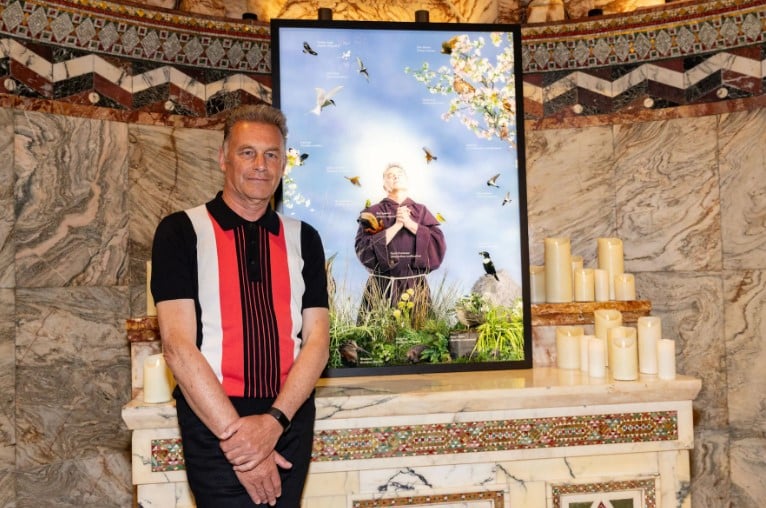The popular TV presenter Chris Packham has been depicted as St Francis of Assisi in a portrait that is described as celebrating him as a “living saint” for the work he has done.
The picture of the well-known English naturalist, best known for his work on the <em>BBC </em>nature series <em>Springwatch</em>, which he has presented since 2009, and for other popular nature programs such as the beloved 1980s children's program <em>The Really Wild Show</em>, was originally commissioned by<em> Radio Times</em> magazine to mark Earth Day, <a href="https://www.telegraph.co.uk/news/2025/05/14/chris-packham-poses-saint-francis-of-assisi-new-portrait/"><mark style="background-color:rgba(0, 0, 0, 0)" class="has-inline-color has-vivid-cyan-blue-color">reports</mark></a> the <em>Daily Telegraph</em>.
The portrait of the presenter and environmental campaigner – in which he is depicted dressed in a monk's habit, with hands clasped and eyes closed as if in prayer – is the work of the celebrated photographic artist Richard Ansett, whose often provocative works can be found around the world in collections at the likes of the UK's National Portrait Gallery and at the Smithsonian in the US.
The image is now on show atop the altar of the <mark style="background-color:rgba(0, 0, 0, 0)" class="has-inline-color has-vivid-cyan-blue-color"><a href="https://www.fitzroviachapel.org/">Fitzrovia Chapel</a> </mark>in central London, and is available to view at the former chapel of the Middlesex Hospital until May 21.
The first Earth Day occurred on 22 April 1970 and since then the <a href="https://www.earthday.org/"><mark style="background-color:rgba(0, 0, 0, 0)" class="has-inline-color has-vivid-cyan-blue-color">annual event</mark></a> aims to remind and mobilise people to protect the planet.
In the hyper-realistic image, Packham is surrounded by some of the UK’s most endangered species. These include the red squirrel, the house martin, the woodcock and the hedgehog.
“Packham’s remarkable connection to the natural world drives him relentlessly to save us from ourselves,” said Ansett, describing the work as “elevating him to the status of living saint”.
Ansett noted that the portrait also made reference to Packham’s "neurodiversity", after the presenter was diagnosed with autism in this 40s, reports the <em>Telegraph</em>.
,
Packham said: “This photo is about a fundamental level of engagement, an engagement of equals. It conveys the importance of nature to heal us, provide us with a sanctuary in times of terrible trouble.
“But the species featured are also rare or declining so it serves to remind us that our one and only home, our Earth, is on a brink too many are refusing to see and act to protect and repair.
“This is a photograph about love, a love of life, all life.”
Previous works by the award-winning Ansett that have contained a religious theme – as well as stirring some controversy – include one of the cross-dressing artist Sir Grayson Perry in the style of the Madonna and Child.
The Packham portrait “recognises the difficulties that he has prevailed over to become a success in his career and a positive light for so many people”, the photographer said.
"[It is] a personal tribute to Packham’s humanity in challenging the worst parts of ours, in our ambivalence to the destruction created in the wake of our own needs."
As Bishop Robert Barron noted in a <a href="https://firstthings.com/francis-in-full/"><mark style="background-color:rgba(0, 0, 0, 0)" class="has-inline-color has-vivid-cyan-blue-color">recent article</mark></a> for <em>First Things</em>, a key theme of Pope Francis's papacy was care for the earth.
"I understand that, in making this remark, I can leave the impression Pope Francis was little more than a standard Euro-left environmentalist, but this would be a gross misinterpretation," writes the US bishop of the Diocese of Winona-Rochester, who is also the founder of Word on Fire Catholic Ministries. <br><br>"When his encyclical <em><a href="https://www.vatican.va/content/francesco/en/encyclicals/documents/papa-francesco_20150524_enciclica-laudato-si.html" target="_blank" rel="noreferrer noopener"><mark style="background-color:rgba(0, 0, 0, 0)" class="has-inline-color has-vivid-cyan-blue-color">Laudato Si</mark></a></em> appeared, many thought of it as the 'global warming' letter, but this is rather spectacularly to overlook the biblical and philosophical underpinning of the text.
"In calling the Church back to a concern for the earth, which had become, in the pope’s memorable phrase, 'a pile of filth', he was appealing to a biblical and premodern sensibility that situated humanity in the wider framework of God’s creation."
Barron then goes on to note that an "inspiration for <em>Laudato Si</em> was, of course, St. Francis of Assisi", before adding that "so too, was the hugely influential twentieth-century theologian who was the subject of the young Jorge Bergoglio’s doctoral research, namely, Romano Guardini".
"In a number of texts, but especially in his early-career <em>Letters from Lake Como</em>, Guardini had sharply criticized the manner in which modern philosophy – anthropocentric and technocratic – had effected, in the long run, an abuse of nature," Barron writes. "He lamented the decline from the older architecture around Lake Como, which conformed to the patterns and rhythms of nature, to the newer buildings that imposed themselves aggressively on the environment.
Under the influence of Guardini, Barron says, "Pope Francis scorned a Cartesian rationalism that would 'master nature' and a Baconian scientism that would 'put nature on the rack' so as to compel it to reveal its secrets."
The US bishop adds: "The pope’s preference for a pre-modern perspective on the relationship between human beings and the environment brought him close to the perspectives of Thomas Aquinas and the author of Genesis. It is worth noting, as well, that in this regard, Francis’s thought echoed closely that of Benedict XVI, who was known as 'the green pope'."
<em>Photo: Chris Packham with his portrait in the Fitzrovia Chapel (screenshot).</em>



